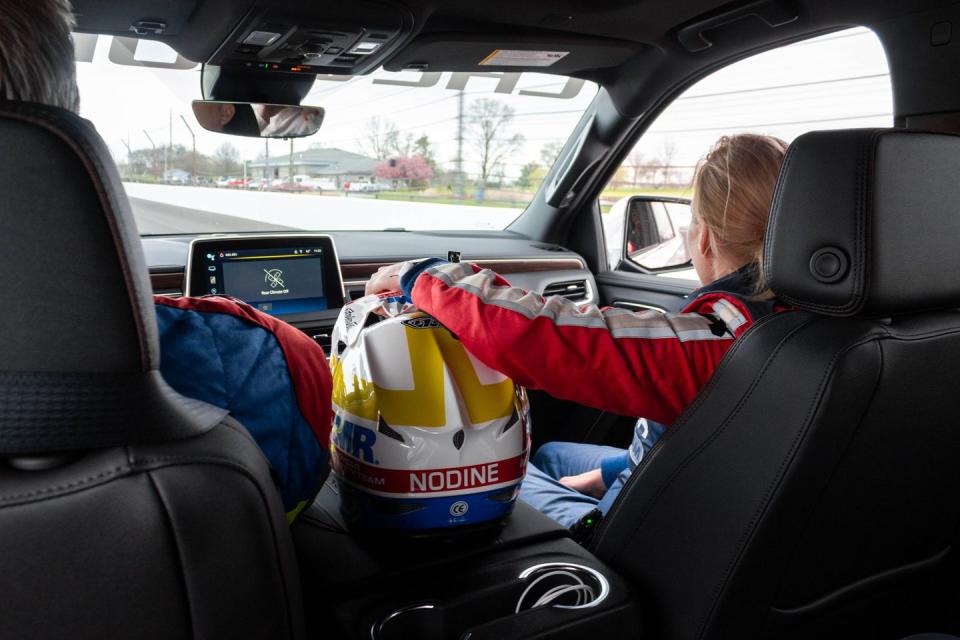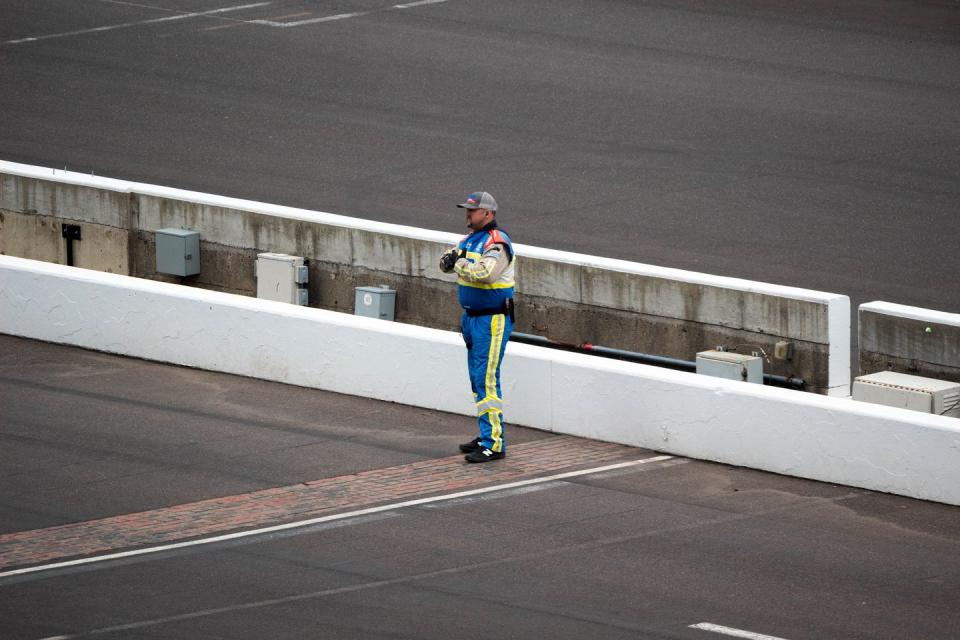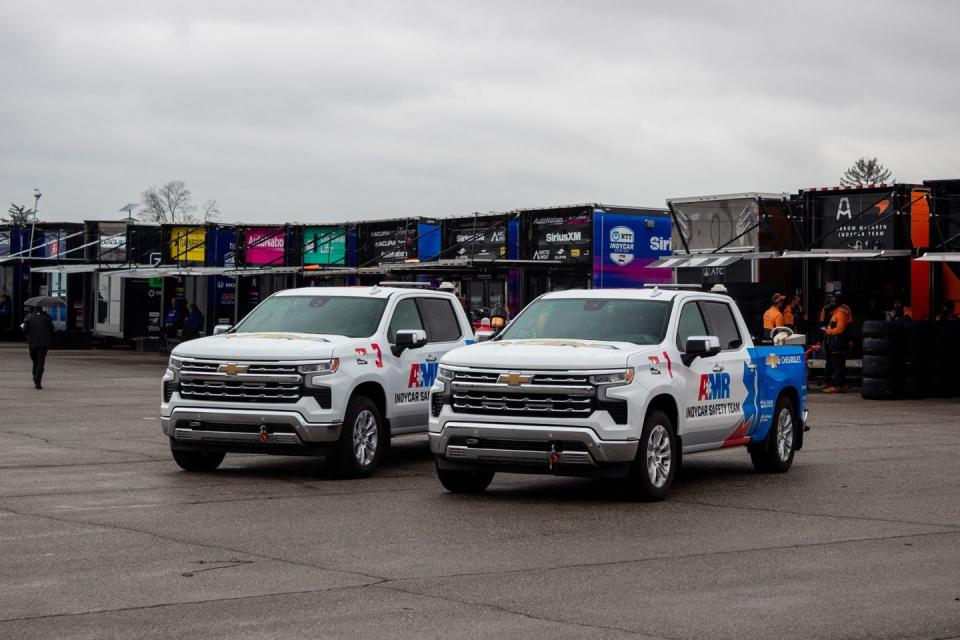When You Watch the Indy 500, Take Note of IndyCar's AMR Safety Team

"Do you see it?"
I looked to where Chris Nodine, a 16-year veteran of IndyCar's American Medical Response (AMR) Safety Team, was pointing on track. He was sitting in the driver's seat of a 2024 Chevrolet Suburban used as a medical vehicle, and I was sitting behind, staring at a thin streak of water on the truck's windshield. I'd joined Nodine and the safety crew for a first-hand look at how IndyCar handles its biggest race of the year, the Indy 500.
This was a few weeks before the race, during open testing in April, and we were parked just inside the Turn 2 barriers at the Indianapolis Motor Speedway (IMS). The cars were working their way around the big oval, testing the limits of speed and grip. An armada of dark, billowing clouds had rolled in, and the radio crackled with sightings of moisture on track. The sky still looked dry to my untrained eyes, but with slick-tire-shod missiles hurtling across the bricks at 200-plus mph, any rain was too much rain to keep cars on track. Seconds later the caution flag flew, and we pulled out onto the banked turn to begin reconnaissance laps.
IndyCar first began using an official safety team made up of the same crew members at each race in 1996, when an organizational rift split the sport into two competing bodies, CART and IRL. The latter adopted the IMS safety team as its own, and the group has attended every IndyCar race since. Within the sport, the AMR corps is renowned for its rapid response times and consistent, measured approach both in protecting drivers' lives and quickly returning the track to race-ready conditions by removing cars and repairing walls.
"People don't pay to see us working. They want to see green-flag racing," explained the team's director, Tim Baughman. Because the goal is to complete their work efficiently before fading into the background when the wheel-to-wheel competition resumes, the people behind the squad's noble efforts often go overlooked.

If that sounds like the perfect job for you, just know that there's no clear-cut application process. Baughman, who has been with the team since its inception, seeks experience and poise. "Most of the time it's word of mouth," he revealed. "Somebody will say, 'This cat out here, they've got their stuff together,' and I'll reach out."
Like many on the squad, Nodine—the crew chief on one of the group's three 2024 Chevy Silverado trucks, each fitted with a dazzling array of tools—started in a different role at IMS. In 1992 he served on an ambulance treating fans, before moving into pit lane as an EMT and then being recruited by the safety team in 2008. Each member is certified for fire rescue operations, and roughly a third are also paramedics. But along with certifications, they need to bring a deliberate, seasoned confidence. "The motorsports environment happens a lot faster," explained Baughman. "There's a lot more cameras on you, and it can be very risky."
The safety crew is a team of leaders, as unlikely as that may sound to those used to a more military order of command. Many have risen through the ranks to become chiefs of their local fire departments, but they've sought out the Indy job as a way to keep their skills sharp. When you become chief, Baughman said, you do fewer of the hands-on operations that appeal to rescue workers in the first place.
"I came here to get away from being a chief and continue to be a worker bee," explained Baughman, who also previously served with Indiana Task Force 1 during 9/11 and several hurricanes. "The people we recruit want to work harder and don't ever want to stop training."

It's not all action, though. Motorsports safety is a strange mix of sitting around twiddling your thumbs until you're needed, and then being needed right away in high-pressure situations. "99 percent of the time we're bored as hell," said Nodine. "And then you've got 1 percent where it's like, oh boy." Sitting shotgun in the Suburban while we monitored the rain was Dr. Melissa McCarthy, described by Nodine as the team's "resident brain." McCarthy likened the mix of idleness and hubbub to her prior military service. While some crew members pass time with movies, McCarthy—an IndyCar fan since she was 11—prefers streaming the race on Peacock from the truck.
When not traveling the country to different racetracks, both Nodine and McCarthy work stressful day jobs. Nodine, formerly an arson investigator, is now the chief of a fire department outside Indianapolis, while McCarthy works in the emergency room downtown. Balancing their occupations with the safety team schedule is certainly difficult. "I'm either traveling, at a track, or working in the emergency department," said Dr. McCarthy. "I love doing it, but every Monday I'm so tired." Nodine noted another effect of the travel: "When my son played T-ball, I missed a lot of games. You never get those back."
The intensity of their day jobs, however, makes them prepared for any situation thrown their way at the racetrack. Even when emotions run high—like when Scott Dixon and Will Power crashed at Road America in 2023, prompting a flurry of middle fingers and aggressive shoves—the safety team is unfazed. "They don't kick me, punch me, or spit on me, so that's nice," joked McCarthy. "That's my day job."
As long as the squad can ensure the drivers' safety and corral them into the medical car, they let the drivers hash things out. "They know this is a safe space," McCarthy said. "They'll sit here and bicker. I've had five drivers in one truck together be like, 'Was that you? You hit me!' But they get over it."

Since the safety team travels with the series, the crew builds a rapport with drivers. "If a driver wrecks and gets his bell rung, he comes to and recognizes us," Nodine said. "I think that's a very comforting thing." Baughman even said that Al Unser Jr., who won the 500 twice in the 1990s, would thank the team when they arrived at the scene of an accident, calling him the "kindest crasher." IndyCar also uses the same medical director at every race, who works with the safety team and conducts the drivers' physicals at the start of the season. Decisions regarding a driver's race-worthiness after a crash stay consistent no matter where the race is.
The group is also always innovating. "I don't go a month without somebody saying, 'I've got a better way of doing this,'" said Baughman. They work closely with partners like Holmatro to redesign tools for improved efficiency. The Holmatro cutter tools—used to slash through carbon fiber—previously ran via cumbersome bundles of lines from a hydraulic pump in the bed of the trucks. But now they're powered by lithium-ion batteries, making them 100 percent portable. They can even operate under 10 meters of water and have a spotlight, easing work in wet weather.
Baughman is also in the process of redesigning the trucks to shift all of the equipment on the tray—which smoothly slides in and out of the bed—under the bed's edges. Not only will this look sleeker, but it will lower the center of gravity and reduce effort for the crew, with everything accessible from the tailgate instead of having to be lifted up and out. EnforcerOne, which produces the fire suppression systems, created a more compact custom tank that now slots in sideways. The truck's cab will also gain a mount with a fire extinguisher and an oil dry can, so the crew can get to work as soon as the truck stops. Time is crucial. As Baughman said, "Every second counts."

The AMR Safety Team also influences major series-wide safety decisions. The aeroscreen, which protects drivers from flying debris, was shaped so the AMR crew could remove a driver quickly "without maneuvering their head, neck, or spine," and Baughman sent his squad's extraction equipment to the engineers developing the aeroscreen so they could test with it. Racetrack design also falls under Baughman's purview, as he determines where they need to place trucks and have extra cutouts for access.
EV and Hybrid Race Cars Have Special Issues
IndyCar plans to launch a hybrid powertrain later this year, bringing a new challenge and new protocols. Errors can sometimes cause hybrid and electric cars to become unsafe to touch, resulting in a nasty electrical shock. "We're dealing with the low-voltage supercapacitor," said Baughman. "It's going to make us approach cars differently." The hybrid setup also gives drivers an onboard starter, so the safety team will need to approach with more caution than before, when they externally restarted stalled cars. "We'll approach it like an aircraft; you have to come around so the driver can see you," said Baughman.
The group's title partner, American Medical Response, plays a large role in its success. Its parent company, Global Medical Response, is one of the largest emergency response providers in the world. When the team discovered a special saw for cutting chinstraps in Sweden that wasn't offered stateside, AMR purchased eight, which all arrived within three days of the initial query. The personnel's helmets, which Baughman estimated were worth $40,000, were also bought by AMR.
But it's ultimately the people operating the tools that are to thank for keeping the drivers safe and letting us get back to watching absurdly fast cars drive in circles inches from each other. "The formula for IndyCar with a traveling team that understands the cars, drivers, and tracks makes the sport safer for our competitors and our responders," said Baughman. It's what allows them to reach the scene of a crash in 30 seconds and manage myriad responsibilities with ease, from driver safety to cleaning up debris and getting stricken cars hauled away.
I wasn't hoping for a crash, but it turned out that my stint would be even less action than usual. After nearly a dozen tours of the speedway, the rain continued to fall with no sign of abatement. Although Nodine and McCarthy would stand by until the official call from race control to end the test, they were both resigned to the fact that the day was done. But the team would be back at the track soon enough, with the ramp up to the Indy 500 beginning in May, where once again they will tirelessly and deftly work in the background to keep the greatest spectacle in racing underway.
You Might Also Like

 Yahoo Autos
Yahoo Autos 